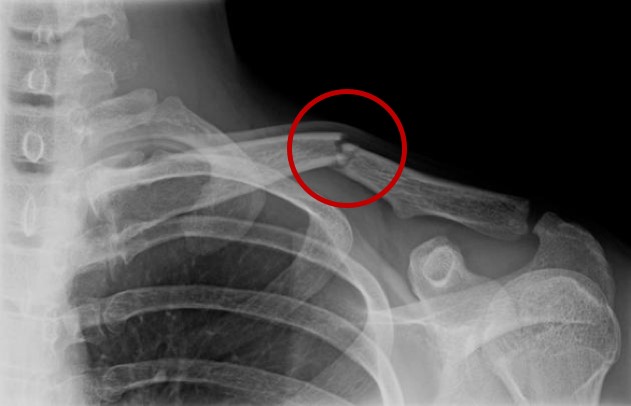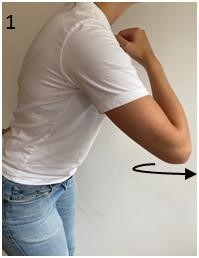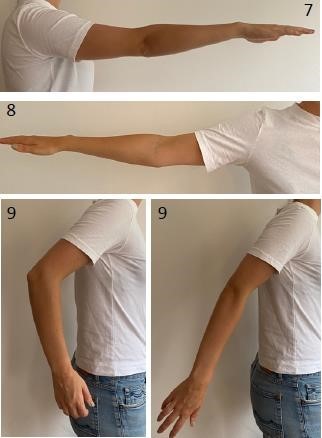Introduction
You have a fracture in the collarbone (clavicle). The position of the bones is good and the fracture should mend properly. The fracture is in the middle part of your collarbone. The treatment consists of wearing a sling, having a short rest period and doing specific shoulder exercises.
Overview- The fracture is in the middle part of your collarbone.
- This injury usually recovers well.
- An outpatient check-up is generally not necessary, so there is no need to make a new appointment.
- Wear a sling for support for the first 3 weeks. Take it off when the pain has subsided to a tolerable level.
- Do not move the arm above shoulder level in the first 3 weeks (see photos below).
- Please find an instructional video for reapplying the sling in the Virtual Fracture Care app.
- It is important that you do exercises during your recovery to prevent the shoulder from becoming stiff.
- Appropriate exercises can be found in this leaflet or in the Virtual Fracture Care app.
- If you have any questions or problems during the recovery, do not hesitate to contact us on “breuklijn” (fracture hotline): (0314) 32 92 50 on work days between 10:00 - 12:00. This Hot Line is easily accessible in case your pain does not subside.
|
The treatmentThe fracture is in the middle part of your collarbone. This fracture is common and usually mends without any problems. The treatment consists of wearing a sling, having a short rest period and doing suitable exercises. This way you will experience less pain, the fracture will heal the fastest and you will reduce the risk of permanent injuries.

First week
|
- Use the sling for support
- Train your shoulder as much as your pain or physical complaints allow.
|
| Week 1-3 |
- Use the sling for support
- Train your shoulder as much as your pain or physical complaints allow.
|
Week 3-6
|
- Take off the sling
- Train your shoulder as much as your pain or physical complaints allow.
|
Week 6 onwards
|
- Use your shoulder as you were used to before your injury, depending on the complaints
- Keep repeating the exercises until your shoulder functions normally again
- You can resume sports or gymnastics. It can take up to 3 months before all physical complaints are gone.
|
InstructionsThe following instructions are important to allow for a good healing:
- Have you received a sling? Use it for the first 3 weeks to give the collarbone a rest. When you go to sleep you can take off the sling.
- Please find instructions for reapplying the sling in the Virtual Fracture Care app.
- After your visit to the hospital, you can start training your shoulder as much as your pain or physical complaints allow. It is important that you start exercising in time to prevent shoulder stiffness. You can find the exercises and instructions in the Virtual Fracture Care app or in the leaflet. Increase the intensity of the exercises at a leisurely pace according to the instructions.
- Train your arm and shoulder depending on your physical complaints. This means you can use the arm and shoulder for as long as you can tolerate the pain.
- You are not allowed to play sports for the first 6 weeks. After that you can slowly start exercising, as far as your pain complaints allow. It can sometimes take up to 3 months before you can exercise without complaints.
- Physical therapy is usually not necessary. If you are dissatisfied with the function of your shoulder after 6 weeks, please consult a physiotherapist.
- Do you have pain? Use paracetamol if needed. Do not wait to take paracetamol until you are in too much pain. Always take it throughout the day. You can take 2 tablets of 500 mg paracetamol up to 4 times a day at fixed times. If paracetamol is not effective, you may use the painkillers you received at the emergency department in addition to paracetamol. Always use it according to the doctor's instructions.
Recovery- Generally, a check-up at the outpatient clinic is not necessary. The fracture usually heals completely within a few weeks. It may take up to 6 weeks before you can fully use the arm and shoulder again.
- After the fracture has healed, a bulge may remain where the collarbone was broken. This is part of the healing process and does not impair its function. In some cases, this bulge persists.
- Does the pain get worse or has the pain not subsided after 3 weeks? Please contact the Fracture Hot Line. If a check-up seems necessary, we will schedule an appointment.
- If you have any questions or problems during the recovery, do not hesitate to contact us on work days between 10:00 - 12:00 via the Fracture Hot Line.
Rehabilitation exercisesFollowing a fracture of the collarbone, stiffness and loss of strength of the shoulder can occur. Below are some specific exercises you can do to prevent this as much as possible. You can also find them in the Virtual Fracture Care app.
Important! Do not overstep your own physical limits while exercising. Pain can be a sign of overexertion. If you feel pain, stop exercising. You may feel fatigue or muscle aches.
Train your shoulder in a calm and controlled manner, and as far as your pain allows. Do not move the arm above the shoulder for the first 3 weeks. During the first week it is wise to wear the sling for support. You can then take it off if the pain allows it. Try to keep the sling off more and more, if you can tolerate it. Keep repeating the exercises from the previous weeks.
Do not proceed to the next step in the exercises until you are able to perform the previous exercises.
When do I do which exercise?Week 1
- Move the fingers and wrist - supported by the sling if needed - by making a fist 10 to 15 times a day and bending and stretching it with your wrist.
- Straighten and bend your elbow 10 to 15 times a day.
- Press your forearm against your stomach. Hold this position for a few seconds and let go.
- Press your forearm against the side of your chest. Make sure your forearm is against your stomach. Hold this position for a few seconds and let go.
- Bend over slightly and make small circular motions with your elbow (pendulum movement)(1).
|  |
Week 2
- Repeat 10-15 times in a row, 3 to 4 times a day.
- Press your stretched forearm against the side of your body. Hold this position for a few seconds and let go (2).
- Bend over slightly and let your arm hang down, stretched. Make small circular motions, clockwise and counter-clockwise (3).
- Bend and stretch the elbow while bent forward (4).
- Repeat 10-15 times in a row, 3 to 4 times a day.
|   |
Week 3-4
- Move your hand over your chest towards your healthy shoulder and try to tap the shoulder blade. Support your elbow with your other hand (5).
- Place your hands against each other in front of your chest and press them together. You will feel the muscles at the front of your shoulder working (6).
- Stretch your arm. Bring it forward and lift it to shoulder height (7). Try to hold the arm here for a moment.
- Lift your stretched arm sideways up to shoulder height. If necessary, use a wall for some support (8). Try to hold the arm here for a moment.
- Move your arm backwards slowly with a stretched or bent elbow (9).
- Alternate the exercises. Repeat 10-15 times in a row, 3 to 4 times a day.
|   |
Week 5-6- Repeat the exercises from week 3-4, now gently lifting the arm above shoulder level. You may move your arm as far as the pain allows.
- Alternate the exercises and perform them at a leisurely pace. Repeat 10-15 times in a row, 3 to 4 times a day.
Week 6 onwards- You may return to using the shoulder as you did before the fracture. Continue the exercises from the previous week until you feel that you can do the same as you could before the fracture.
- Swimming is a good exercise to get the shoulder function back to normal.
- If you feel that you can do fewer exercises due to less strength or pain, guidance from a physiotherapist is recommended. You can arrange this yourself with or without a referral from your GP.
Questions?You can call us
If there are any questions after reading the information, please contact us or visit www.slingeland.nl.
Contact
Breuklijn, (0314) 32 92 50. Please call us on work days between 10:00 - 12:00. |
Virtual Fracture Care app Find more information about your injury in our app. The app also includes exercises that promote your recovery. You can find the app in the App Store (iPhone) or Google Store (Android).
You can also scan the QR code. You will then automatically be redirected to the app.










